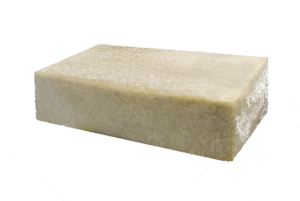RUBBER

Diene elastomers playing a crucial role in many fields of use possess a frontal position in our offer.
Elasticity is the key feature of these materials, corresponding to low glass transition temperature (mostly below 0°C). Thanks to vulcanization process, which consists of developing a spatial network of each individual macromolecules, profound rubber properties are obtained. For this purpose, chemical structure of polydiene backbone chains is used in crosslinking reactions, due to the presence of unsaturated bonds. To carry our curing of the rubber, reactive sulfur atoms must be involved. However, this radical nature process is usually slow, thus has to be accelerated by organic catalysts and activators like metal oxides (i.e. ZnO). Vulcanizate having up to 4% wt. of sulfur retains pristine rubber matrix elasticity, but further crosslinking yields to products of substancial hardness and high degree of double bonds saturation.
On account of huge reactivity of unsaturated bonds present in rubbers, the latter must be stabilized against negative influence of external factors. Technically, appropriate content of antioxidants, antiozonants and UV stabilizers is capable of delaying so-called rubber aging, which leads to gradual decrease in elasticity and bursting of the goods.
Natural rubber (NR)
Commercial NR is derived from certified crops of Hevea brasiliensis trees, as well as from vast number of rubber plants species. In case of the trees, after the cultivation the bark is tapped by harvestrs and tacky, milky fluid called latex is collected. Latex is subsequently coagulated with acid, that precipitates cis-polyisoprene polymer, which has to be washed in water and after further processing formed into slabs (briquettes).
Amongst innumerable applications of NR obtained by precipitation, one should mention vulcanizated rubber goods (used in tire, automotive, leathery, footwear and technical industries) and glues (NR in hydrocarbon solvents).
| Parameter | TSR 5 | TSR 10 | TSR 20 | L/3L/5L | 10 CV | 20 CV | CV50/CV60 | Test method |
| Colour coding, marker | Green | Brown | Red | Green | Brązowy | Czerwony | Zielony | – |
| Dirt, % max. | 0,05 | 0,08-0,10 | 0,16-0,20 | 0,02/0,03/0,04 | 0,08 | 0,16 | 0,02 | ASTM D 1278 ISO 249 |
| Ash content, % max. | 0,60 | 0,75 | 1,0 | 0,50 | 0,75 | 1,0 | 0,5 | ASTM D 1278 ISO 247-1 |
| Volatile matter, % max. | 0,80 | 0,80 | 0,80 | 0,80 | 0,80 | 0,80 | 0,80 | ASTM D 1278 ISO 248-1 |
| Initial Wallace plasticity, (Po) min. | 30 | 30 | 30 | 35 | 30 | 30 | – | ISO 2007 |
| Plasticity Retention Index PRI, min. | 60 | 50 | 40 | 60 | 50 | 40 | 60 | ISO 2930 |
| Lovibond colour index, max. | 6 | ISO 4660 | ||||||
| Mooney Viscosity, ML | 60 (±5) | 60 (±5) | 50/60 (±5) | ISO 289-1 | ||||
| Nitrogen content, % max. | 0,60 | 0,60 | 0,60 | 0,60 | 0,60 | 0,60 | 0,60 | ISO 1656 |
RSS – Ribbed Smoked Sheet natural rubber of RSS1 to RSS5 grades is available on request.